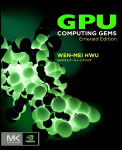GPU computing gets real work done -- faster
 I have been reading an interesting book about GPU computing called GPU Computing Gems: Emerald Edition, Wen-Mei W. Hwu, editor-in-chief, Morgan Kaufmann (ISBN: 9780123849885). The book provides a large breadth of GPU HPC topics across many different disciplines. In addition, this is not a "how to" book although some of the software discussed in the book is available on-line and it deals exclusively with what are considered HPC applications. The book provides well documented examples of GPU computing in a large spectrum of application areas by prominent researches. There is definitely an academic rigor applied to the content as evidenced by long list of editors, reviewers, and large index.
I have been reading an interesting book about GPU computing called GPU Computing Gems: Emerald Edition, Wen-Mei W. Hwu, editor-in-chief, Morgan Kaufmann (ISBN: 9780123849885). The book provides a large breadth of GPU HPC topics across many different disciplines. In addition, this is not a "how to" book although some of the software discussed in the book is available on-line and it deals exclusively with what are considered HPC applications. The book provides well documented examples of GPU computing in a large spectrum of application areas by prominent researches. There is definitely an academic rigor applied to the content as evidenced by long list of editors, reviewers, and large index.
Before I offer some opinions, let's first take a look at the breath of coverage. There are 50 chapters spread over 856 pages in the following sections:
- Scientific Simulation
- Life Sciences
- Statistical Modeling
- Emerging Data-intensive Applications
- Electronic Design Automation
- Ray Tracing and Rendering
- Computer Vision
- Video and Image Processing
- Signal and Audio Processing
- Medical Imaging
After a quick perusal of the book, there are two obvious conclusions. First, GPU computing has made a big impact on many areas of science. And second, not many people will read this book cover-to-cover. The range of topics is quite large and I'm sure the molecular electrostatics crew will not be all that interested in real time image recognition, and vis-versa, but who knows. The chapters themselves are quite thorough and each stands on its own. All chapters introduce the topic, provide background (often mathematical) on the problem, a description of the algorithm and how it maps to the GPU, some code snippets, the hardware used, speed-up comparison to X86 multi-core systems, and ample references.
The book can be a valuable resource for those who want to see how GPUs can be used in various disciplines. Virtually all results are for CUDA and NVidia hardware although OpenCL and AMD/ATI results show-up occasionally. The green cover art should be the first tip-off that this is an NVidia based book.
I would recommend this book to anyone who is serious about studying and using GPUs for their research. There is a chance one of the chapters will touch on a topic of interest. Sadly, with such a broad spectrum of topics, I expect individual readers will benefit from only a small portion of the book. As part of a library, this book can be an excellent resource for many different readers. Finally, I find it interesting that the editor in chief, Professor Wen-mei W. Hwu is the Jerry Sanders III Advanced Micro Devices, Inc., Endowed Chair at University of Illinois, Urbana. Funny how things work out.